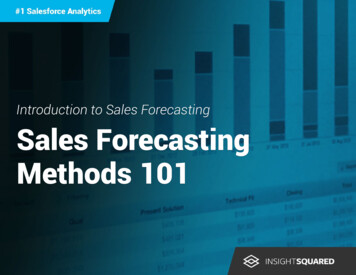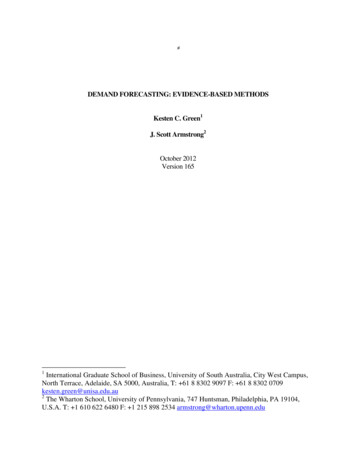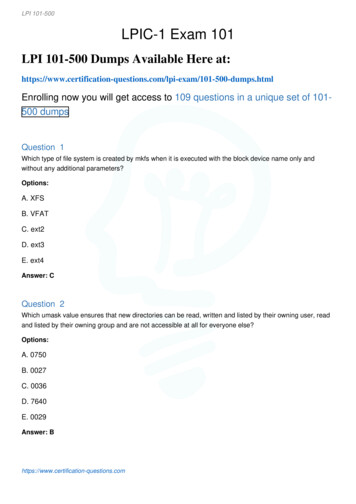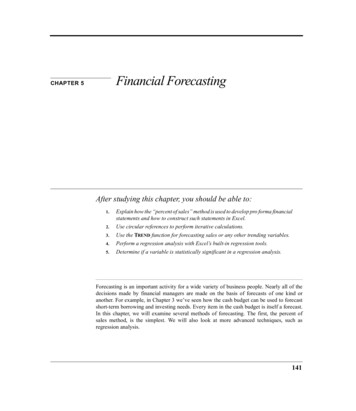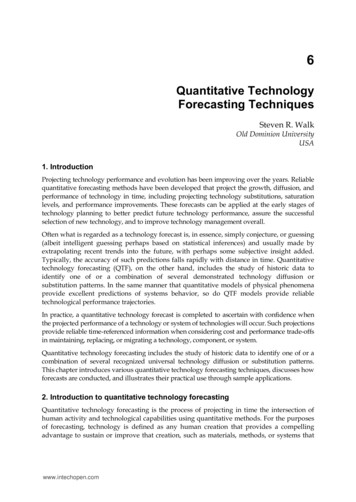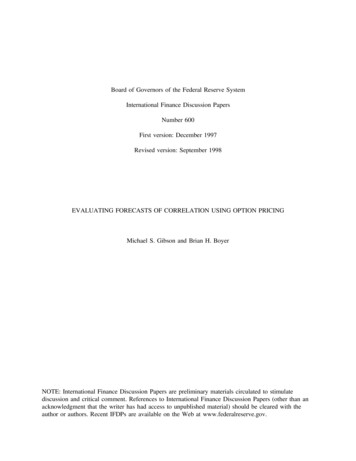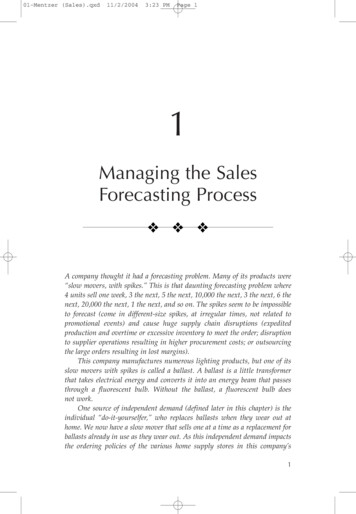
Transcription
01-Mentzer (Sales).qxd11/2/20043:23 PMPage 11Managing the SalesForecasting Process A company thought it had a forecasting problem. Many of its products were“slow movers, with spikes.” This is that daunting forecasting problem where4 units sell one week, 3 the next, 5 the next, 10,000 the next, 3 the next, 6 thenext, 20,000 the next, 1 the next, and so on. The spikes seem to be impossibleto forecast (come in different-size spikes, at irregular times, not related topromotional events) and cause huge supply chain disruptions (expeditedproduction and overtime or excessive inventory to meet the order; disruptionto supplier operations resulting in higher procurement costs; or outsourcingthe large orders resulting in lost margins).This company manufactures numerous lighting products, but one of itsslow movers with spikes is called a ballast. A ballast is a little transformerthat takes electrical energy and converts it into an energy beam that passesthrough a fluorescent bulb. Without the ballast, a fluorescent bulb doesnot work.One source of independent demand (defined later in this chapter) is theindividual “do-it-yourselfer,” who replaces ballasts when they wear out athome. We now have a slow mover that sells one at a time as a replacement forballasts already in use as they wear out. As this independent demand impactsthe ordering policies of the various home supply stores in this company’s1
01-Mentzer (Sales).qxd211/2/20043:23 PMPage 2SALES FORECASTING MANAGEMENTsupply chain, we get the fairly smooth, slow-moving component of deriveddemand (also defined later in this chapter) that the company experiences.However, there is another source of independent demand for ballasts. Theowners of a large office building decide to retrofit all the ballasts in their building. This is a return on investment (ROI) decision, because old ballasts usemore electricity to light the fluorescent bulb than new ballasts do; that is, atsome point, the cost of replacing the ballasts can be justified on the basis of thesavings in electric bills. The office building in question has 10,000 ballasts thatneed to be replaced. When the building owner decides to retrofit the ballasts inthe building (generally in connection with some other renovations), an electrical contractor is chosen to do the job, who then works with the other contractorsinvolved in the renovation to decide when to start the ballast retrofitting part ofthe overall project, usually weeks or months in the future.Unfortunately, the electrical contractor does not tell the company about theindependent demand for 10,000 ballasts until the week before they are needed.Because it typically takes this company 3 weeks to fill an order of this size, thecompany incurs higher supply chain costs (expedited production costs, costs ofhigher inventory levels, spot market procurement costs, outsourcing production to higher cost alternatives) associated with expediting a large order, andthe company makes far less (if any) money on this large order.By recognizing that the demand impacting this company was deriveddemand (derived from the contractor’s ordering policies), not independentdemand, the company shifted its emphasis from forecasting the spikes in independent demand to demand planning for the derived demand. The result was anew demand planning policy in this supply chain; the company now offers contractors a 3% price discount on any orders in excess of 10,000 that are placedwith the company five or more weeks before they are needed. This is a considerable savings for the contractors (3% off an order of 10,000 units, each of whichtypically costs more than 20!) and results in increased sales for the company.More importantly, however, this company turned the unplanned largespikes hitting their operations systems into demand that could be plannedweeks before needed. Under the new demand planning system, the companyknows about spikes (that take 3 weeks to fill) 5 weeks in advance. This meansthat instead of expedited production, overtime, higher procurement costs, andunwanted, expensive outsourcing of production, the company can actuallyproduce the products to fill the order anytime during the 5 week window,usually in slack production times. This “smoothing out” of the productionscheduling system saves this company millions of dollars every year—allwith increased market share among the contractors. This would not have beenpossible without the realization that the demand the company was trying toforecast was actually derived demand that could be planned.
01-Mentzer (Sales).qxd11/2/20043:23 PMPage 3Managing the Sales Forecasting Process3 INTRODUCTIONMuch like the example just given, this book is about much more thanjust techniques. In fact, it is about more than just sales forecasting.It is about three management activities in any supply chain: demandmanagement, demand planning, and sales forecasting management. A DEMAND MANAGEMENTAPPROACH TO SALES FORECASTINGThe role of sales forecasting changes depending upon the position inthe supply chain that a company occupies. Any supply chain has onlyone point of independent demand: the amount of product demanded(by time and location) by the end-use customer of the supply chain. Whetherthis end-use customer is a consumer shopping in a retail establishmentor online (B2C), or a business buying products for consumption in theprocess of conducting its business operations (B2B), these end-usecustomers determine the true demand for the product that will flowthrough the supply chain.The company in the supply chain that directly serves thisend-use customer directly experiences this independent demand. Allsubsequent companies in the supply chain experience a demand thatis tempered by the order fulfillment and purchasing policies of othercompanies in the supply chain. This second type of supply chaindemand is called derived demand, because it is not the independentdemand of the end-use customer, but rather a demand that is derived fromwhat other companies in the supply chain do to meet their demand from theirimmediate customer (i.e., the company that orders from them).The derived demand for one company is often the dependentdemand of their customers. Dependent demand is the demand for thecomponent parts that go into a product. Often called bill of materials(BOM) forecasting, this is usually demand that is dependent upon thedemand for the product in which it is a component. The exception iswhen different amounts of a component part go into different versionsof the product and is, thus, a special kind of forecasting called statistical BOM forecasting. For example, the manufacturer of a large telecommunications switch may have 50 different component parts thatcan go in each switch, with the number of each component includedvarying from 0 to 5, depending upon the customer order. Thus, theindependent demand of customers for the switch, and the independent
01-Mentzer (Sales).qxd411/2/20043:23 PMPage 4SALES FORECASTING MANAGEMENTdemand of customers for various switch configurations (and theirresulting BOM), must be forecast to determine the dependent demandfor each component part.It is important to note that only one company in any given supplychain is directly impacted by independent demand. The rest of thecompanies in the supply chain are impacted by derived and/or dependent demand. Equally important, the techniques, systems, andprocesses necessary to deal with derived and dependent demand arequite different from those of independent demand.Recognizing the differences between independent, dependent,and derived demand, recognizing which type of demand impactsa particular company, and developing techniques, systems, andprocesses to deal with that company’s particular type of demand canhave a profound impact on supply chain costs and customer servicelevels. We first explore the implications of independent and deriveddemand, followed by a model of the demand management function insupply chain management. We will then move on to the topic of salesforecasting management.Derived Versus Independent DemandFigure 1.1 depicts a traditional supply chain, with a retailer servingthe end-use customer, a wholesaler supplying the retailer, a manufacturer supplying the wholesaler, and a supplier providing raw materialsto the manufacturer. The source of independent demand for thissupply chain is 1,000 units for the planning period. However, theretailer (as is typically the case) does not know this with certainty. Infact, the retailer has a reasonably good forecasting process and forecasts end-use customer demand to be 1,000 units for the planningperiod. Because the forecast has typically experienced / 10% error inthe past, the retailer places an order to its supplier (the wholesaler) for1,100 units (i.e., 1,000 units for expected demand and 100 units forsafety stock to meet expected forecasting error). It is critical to notice inthis simple example of a typical, unmanaged supply chain that thedemand the wholesaler experiences is 1,100 units, not 1,000.The wholesaler, in turn, has a reasonable forecasting system (notethat the wholesaler is not forecasting end-use customer independentdemand, but is inadvertently forecasting retailer-derived demand),and forecasts the demand impacting the wholesaler at 1,100 units.Again, the wholesaler believes the forecasting error to be approximately
01-Mentzer (Sales).qxd11/2/20043:23 PMPage 5Managing the Sales Forecasting ProcessFigure 1.15Demand Error in a Traditional Supply ChainEnd-useCustomer1,210units1,100unitsDemand 1,000 unitsRetailerSafetyStock 10%Wholesaler 10%1,464units1,331unitsManufacturer 10%Supplier 10%Total Demand Error (Safety Stock) 110.5% / 10%, so the wholesaler orders 1,100 plus 10% (or 1,210 units) fromthe manufacturer. If the manufacturer and the supplier both assumethe same / 10% forecasting error, then each adds 10% to its orders totheir suppliers. Note that we are assuming here, for simplicity’s sake,that there is no BOM. If there were, the logic would still hold, but theillustration would become unnecessarily complicated.As Figure 1.1 illustrates, simple failure to recognize the differencebetween independent demand (which needs to be forecast) andderived demand (which can be derived and planned)—even in a supply chain where forecasting error is only / 10%—adds greatly to thesafety stock carried in the supply chain. In fact, because each memberof the supply chain only needed 1,000 units to meet the actual demand,plus 100 units for the potential forecasting error, this particular supplychain is carrying 705 too much inventory ((210–100) (331–100) (464–100) 705), or a 16.0% supply chain wide inventory overstock((705/4,400) 16.0%) for the actual end-use customer demand.Inventory carried for Total Demand Error (Safety Stock) in this supplychain is 1,105 (100 210 331 464), or 110.5% of actual end-use customerdemand!This example allows us to introduce the supply chain concept ofdemand planning, which is the coordinated flow of derived and dependentdemand through companies in the supply chain. Demand planning is illustrated in the Figure 1.2 supply chain. End-use customer demand is thesame as in Figure 1.1, and the retailer’s faith in its forecast ( / 10%) isunchanged. What has changed, however, is that the other companies in
01-Mentzer (Sales).qxd611/2/20043:23 PMPage 6SALES FORECASTING MANAGEMENTDemand Error in a Demand Planning Supply ChainFigure 1.2Demand 1,000 rSupplier 10%Total Demand Error 40.0%the supply chain are no longer even attempting to forecast the demandof their customers. Rather, each member of the supply chain receivespoint-of-sale (POS) demand information from the retailer, and theretailer’s planned ordering based upon this demand. Combined withknowledge of the time-related order flows through this supply chain,each company can plan its processes (including orders to its suppliers).The result is that each member of the supply chain carries 1,100 unitsin inventory—a system-wide reduction in inventory of 13.81% from5,105 (i.e., 1,100 for the retailer, 1,210 for the wholesaler, 1,331 for themanufacturer, and 1,464 for the supplier) to 4,400 (i.e., 1,100 each forthe retailer, wholesaler, manufacturer, and supplier). More importantly,the inventory carried for forecasting error (safety stock) drops from1,105 to 400 (from total demand error of 110.5% to 40.0%)—for a reduction of total demand error inventory (safety stock) of 63.8%((1,105–400)/1,105).Notice, however, that the inventory reductions are not uniformacross the supply chain. Whereas the supplier has a reduction in safetystock of 78.4% (from 464 to 100), the retailer experiences no reduction.In fact, the further up the supply chain, the greater the safety stockreduction. This illustrates a paradox of demand planning in any supply chain—the very companies that are most needed to implementsupply chain demand planning (i.e., implementation of systems toshare with suppliers real-time POS information held by retailers) havethe least economic motivation (i.e., inventory reduction) to cooperate.This leads us to the concept of demand management.Demand management is the creation across the supply chain and itsmarkets of a coordinated flow of demand. Much is implied in this seemingly
01-Mentzer (Sales).qxd11/2/20043:23 PMPage 7Managing the Sales Forecasting Process7simple definition. First, the traditional function of marketing createsdemand for various products, but often does not share these demandcreating plans (such as promotional programs) with other functionswithin the company (forecasting, in particular), much less with othercompanies in the supply chain.Second, the role of demand management is often to decreasedemand. This may sound counter-intuitive, but demand often existsfor company products at a level management cannot realistically (orprofitably) fulfill. Demand management implies an assessment of theprofit contribution of various products and customers (all with capacity constraints in mind—including the capacity of all components inthe BOM), emphasizing demand for the profitable ones, and decreasing demand (by lessening marketing efforts) for the unprofitable ones.Finally, as we mentioned earlier, considerable supply chain savingscan result from demand planning, but the rewards are not always consistent with the need to obtain collaboration from all companies in thesupply chain. Thus, an aspect of demand management is supply chainrelationship management, which is the management of relationships withsupply chain partners to match performance with measurements and rewardsso that all companies in the supply chain are fairly rewarded for overall supply success (measured as cost reduction and increased customer satisfaction).A Model of Supply Chain Demand ManagementThis leads us to an overall model of the role of demand management, demand planning, and sales forecasting management in thesupply chain. Figure 1.3 illustrates these roles. Supply chain management has many aspects, only one of which is demand management.As previously illustrated, demand management encompasses the traditional marketing functions, along with the coordination of marketingactivities with other functions in the company and the supply chain.However, the traditional demand creation role of marketing is tempered in demand management by a desire to coordinate the flow ofdemand across the supply chain (demand planning) and creating incentives for supply chain partners to help manage those flows (supplychain relationship management). Demand planning is concerned withthe coordination across the supply chain of derived and dependentdemand. Sales forecasting management (which is the primary focus ofthis book, but within the overall perspective of Figure 1.3) is concernedwith the independent demand that occurs in any supply chain.
01-Mentzer (Sales).qxd811/2/20043:23 PMPage 8SALES FORECASTING MANAGEMENTFigure 1.3Demand Management in Supply Chain ManagementSupply ChainManagementDemandManagementMarketing /Supply castingManagement SALES FORECASTING MANAGEMENTSales forecasting management is about the management of the salesforecasting function within an organization. It is about recognizing that,although the function is typically called sales forecasting, we are reallytrying to forecast demand—that is, we want to know what our customersdemand so we can plan on achieving sales at or near that level.Sales forecasting involves the proper use of various techniques,both qualitative and quantitative, within the context of corporate information systems, to meet the myriad of needs of the sales forecast usersand to manage this entire process. To manage these multidimensionalaspects, we have to understand each in turn and the managementstructures in which sales forecasting must operate. These will be thetopics of this book. Before going any further, however, we shouldunderstand exactly what we mean by sales forecasting and the areawith which it is often confused, planning.
01-Mentzer (Sales).qxd11/2/20043:23 PMPage 9Managing the Sales Forecasting Process9 FORECASTS VERSUS PLANS VERSUS TARGETSFor the purposes of this book, we will define a sales forecast as aprojection into the future of expected demand, given a stated set ofenvironmental conditions. This should be distinguished from operational plans, which we will define as a set of specified managerialactions to be undertaken to meet or exceed the sales forecast.Examples of operational plans include production plans, procurementplans, and distribution plans. Both the sales forecast and the operational plans should be distinguished from the sales target, which wewill define as sales goals that are established to provide motivationfor sales and marketing personnel.Notice that our definition of a sales forecast does not specify thetechnique (quantitative or qualitative), does not specify who developsthe forecast within the company, nor does it include managerial plans.The reason for this is many companies confuse the functions offorecasting, planning, and target-setting. Operational plans for thelevel of sales to be achieved should be based upon the forecast ofdemand, but the two management functions should be kept separate.Similarly, target-setting should be done with a realistic assessment ofexpected future demand in mind, and this assessment comes from thesales forecast. In other words, the functions of planning and targetsetting should be informed by forecasts of demand, but should notbe confused with sales forecasting.Notice that these definitions imply different performance measuresfor sales forecasts than for operational plans. Because the purpose ofsales forecasting is to make projections of demand given a set of specified environmental assumptions, one of the key measures of sales forecasting performance is accuracy of the forecast, and one of the keymethods to explain variances in accuracy is how the environmentvaried from the one defined. This explanation is not intended to excuseforecast inaccuracy; rather, it is meant to help us understand thebusiness environment and forecast more accurately in the future.In contrast, the goal of operational plans is not accuracy,but rather to effectively and efficiently meet forecasted demand. Inaddition, while forecasts are meant to be accurate, targets are meantto be met or exceeded. A mistake made by many companies is to confuse the sales forecast, where the objective is accuracy, with the salestarget, where the objective is to at least meet, and hopefully exceed,the goal or quota. In other words, companies should never be guiltyof confusing forecasting with the firm’s motivational strategy.
01-Mentzer (Sales).qxd1011/2/20043:23 PMPage 10SALES FORECASTING MANAGEMENT THE ROLE OF SALES FORECASTINGIN SALES AND OPERATIONS PLANNING (S&OP)In many companies, sales forecasting is an integral part of a criticalprocess for matching demand and supply that is sometimes referred toas Sales and Operations Planning (S&OP). Figure 1.4 offers a simplifiedpicture of how sales forecasting contributes to the S&OP process. Asseen in Figure 1.4, an enterprise can be thought of as consisting of twoprimary functions: a demand function and a supply function. Demandis the responsibility of sales and marketing. In many companies, thesales organization is responsible for generating and maintainingdemand from large end-user customers, or from wholesale or retailchannel partners. Marketing is usually responsible for generating andmaintaining demand from end consumers. Supply is the responsibilityof a number of functions, including manufacturing, procurement,logistics or distribution, human resources, and finance. It is also theresponsibility of a variety of suppliers, who must provide raw materials, component parts, and packaging. The S&OP process provides a“junction box” where information can flow between the demand sideand the supply side of an enterprise.As shown in Figure 1.4, critical input to the S&OP process is thesales forecast, which is, as defined above, the projection into the futureof expected demand. The sales forecast should originate in the demandside of the enterprise, because it is the demand side of the enterprise(i.e., sales and marketing) that is responsible for generating demandand that should have the best perspective on what future demand willbe. In addition to the sales forecast, which originates in the demandside of the company, another critical input to the S&OP process is acapacity plan. A capacity plan is a projection into the future aboutwhat supply capabilities will be, given a set of environmental assumptions. This input is provided by the supply side of the enterprise anddocuments both long- and short-term supply capabilities. The processthat occurs inside the S&OP process—the junction box—is the matching of future demand projections (i.e., the sales forecast) with futuresupply projections (i.e., the capacity plan).Out of the S&OP process come two critical plans, the operationalplan and the demand plan. As discussed above, the operational planconsists of manufacturing plans, procurement plans, distributionplans, and human resource plans. These various operational plans canbe short-term in nature, such as a monthly production schedule. They
01-Mentzer (Sales).qxd11/2/20043:23 PMPage 11Managing the Sales Forecasting ProcessFigure 1.411S&OP: The Junction BoxSales ForecastDEMANDSales andMarketing,DownstreamChannelPartnersCapacity PlanSUPPLYProduction,Logistics, etc., andUpstreamSuppliersSALES ANDOPERATIONSPLANNING(S&OP)Demand PlanOperational Plancan be long-term in nature, such as extended contracts for raw materials, or even plans to expand manufacturing capacity. The other criticalplan that emerges from the S&OP process is the demand plan, whichinvolves sales and marketing making plans about what should be soldand marketed and when, given the supply capabilities of the firm. Asmentioned above, demand plans may involve suppressing demand forproducts or services that are capacity constrained, or shifting demandfrom low-margin products to high-margin items.Other authors have discussed how to effectively manage theS&OP process within organizations (see, for example, Lapide 2002),and such discussion is beyond the scope of this book. It is important,however, to understand the critical role that sales forecasting plays inthe overall planning activities of the firm. Without accurate and credible estimates of future demand, it is impossible for organizations toeffectively manage their supply chains. WHY IS A SALES FORECAST NEEDED?If we can simply set a sales goal and expect marketing and sales toexceed it, why do we even need a sales forecast in the first place? This
01-Mentzer (Sales).qxd1211/2/20043:23 PMPage 12SALES FORECASTING MANAGEMENTis a question many managers ask and often answer incorrectly (i.e., wedo not need a forecast), to their eventual sorrow.The correct answer is that every time we develop a plan of any kind,we first make a forecast. This is true of individuals, as well as profit andnon-profit companies, government organizations, and in fact, any entitythat makes a plan. It can be as simple as planning what we will weartomorrow. When we decide to lay out wool slacks and a sweater for thenext day, we are forecasting that the weather will be cool. If we add anumbrella to our ensemble, we are forecasting rain. The plan was predicated upon the forecast, whether we consciously thought about it or not.This is not much different from a company making financial plansbased on expected sales and the costs of meeting those sales. The trickis to not get caught in the trap of making “inadvertent sales forecasts.”Inadvertent sales forecasts are made when we are so intent on developing the plan that we simply assume what sales will be, rather thangiving any concentrated thought and analysis to the market conditionsthat will be necessary to create this level of sales.One great example of such an inadvertent forecast came from amanufacturer in the grocery products industry. The owner of the company explained to us that the sales plan called for an increase in sales of5% for the next year. However, we had also been told that this industry inthis country was not growing and that any attempt to grab market sharefrom the competition was only met by counter moves that caused greaterpromotional expenditures, but no shift in market share. “Wait a minute,”we said to the owner. “How can industry size not change, market sharenot change, but sales grow? It does not take a math major to figure outthat this is not going to work.” The answer was that management wouldsimply have to motivate everyone to work harder to achieve the (mathematically impossible) plan. Of course, it is obvious what happened—noamount of motivation can overcome an impossible situation, and thesales plan was not achieved. It was not achieved because it was based onan inadvertent and uninformed forecast. This is also a classic exampleof management confusing forecasting, planning, and target-setting.In this case, no reasonable forecast would predict a 5% increase in sales.The 5% increase should have been seen for what it was—a stretch goal.Let’s look at one more example. A large regional distributor of foodproducts to restaurants develops an elaborate annual profit plan.Hundreds of person-days go into the development of this plan, but italways starts with such comments as, “We need profits to increase nextyear by 6%. Let’s figure out how much sales have to be to achieve that
01-Mentzer (Sales).qxd11/2/20043:23 PMPage 13Managing the Sales Forecasting Process13goal.” Notice that the term “goal” sneaked into that quote. Where theseexecutives should have started was to ask about market and environmental conditions facing the company during the planning horizonand what levels of sales could be expected based upon these conditions. The plan then becomes one of determining what marketing andsales efforts will be necessary to meet and exceed these projections to alevel necessary to achieve the profit plan. The plan cannot drive theforecast; it has to be the other way around.Thus, one of our goals in this book it to help managers see theimportance of the sales forecast as input to their plans and to understand how these sales forecasts can and should be developed. To dothis, as a first step we should talk about the sales forecast needs of theprimary managerial functions within an organization. In other words,what do marketing, sales, finance/accounting, production/purchasing,and logistics each need from the sales forecast as input to their plans?To answer this question, we will first define the related concepts ofsales forecasting level, time horizon, time interval, and form—mainlybecause different management functions require different levels, horizons, intervals, and forms of sales forecasts.The sales forecasting level is the focal point in the corporate hierarchy where the forecast is needed. A corporate forecast, for instance, isa forecast of overall sales for the corporation. The sales forecasting timehorizon generally coincides with the time frame of the plan for which itwas developed. If, for instance, we continue the example just given, acorporate plan may be for the next two years and, thus, we need a salesforecast for that two-year time horizon. The sales forecasting time interval generally coincides with how often the plan is updated. If our twoyear corporate sales plan must be updated every three months (not anunusual scenario), we can say the level is corporate, the horizon is twoyears, and the interval is quarterly. The sales forecasting form is whatneeds to be forecast or planned. Some functions need to know whatphysical units are to be produced and/or shipped, while other functions need to know the dollar equivalents of these units, and otherfunctions need to plan based upon total pounds or cubic volume. Theseconstitute the forms a sales forecast (and a plan) can take.Sales Forecasting Needs of MarketingMarketing is typically concerned with the success of individualproducts and product lines the company offers to its customers. This
01-Mentzer (Sales).qxd1411/2/20043:23 PMPage 14SALES FORECASTING MANAGEMENTconcern usually manifests itself in annual plans (updated monthlyor quarterly) of marketing efforts for new and existing products. Themarketing plans, in turn, usually involve projected product changes,promotional efforts, channel placement, and pricing. To develop theseplans, marketing needs sales forecasts that take these various effortsinto account and project sales (typically in dollars) at the product andproduct line level for an annual time horizon and with monthly orquarterly intervals.Sales Forecasting Needs of Sale
demand (derived from the contractor's ordering policies), not independent demand, the company shifted its emphasis from forecasting the spikes in inde-pendent demand to demand planning for the derived demand. The result was a new demand planning policy in this supply chain; the company now offers con-


